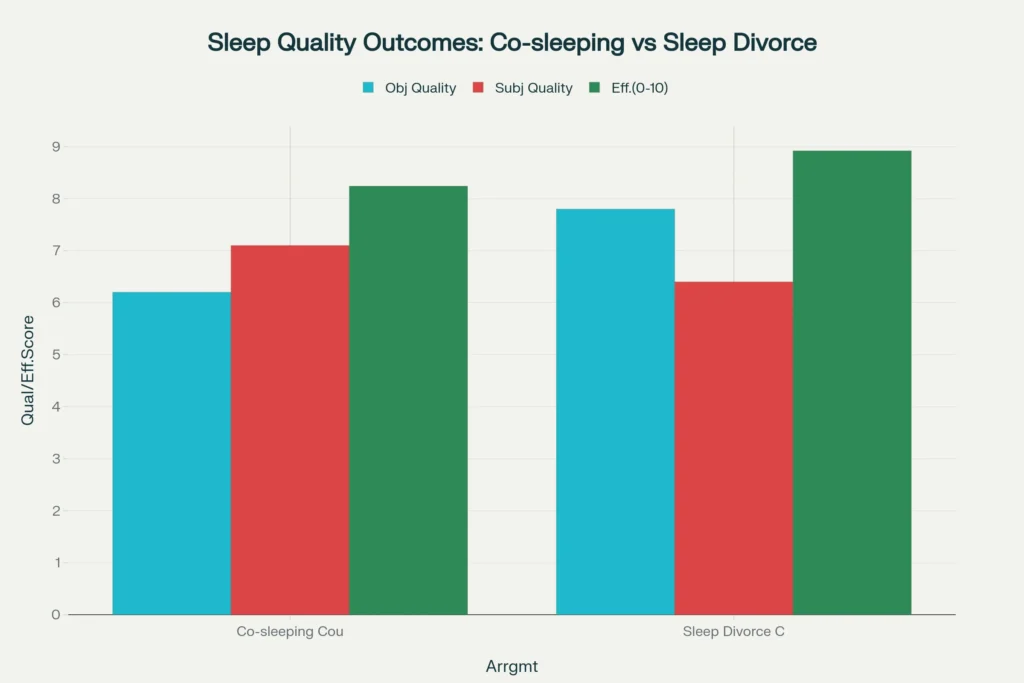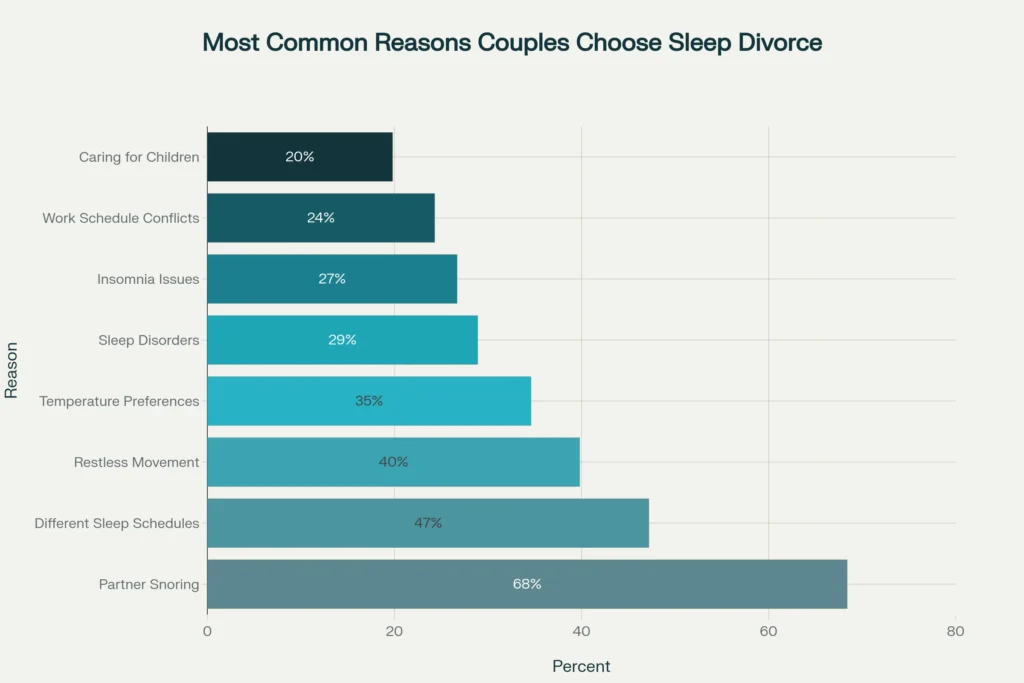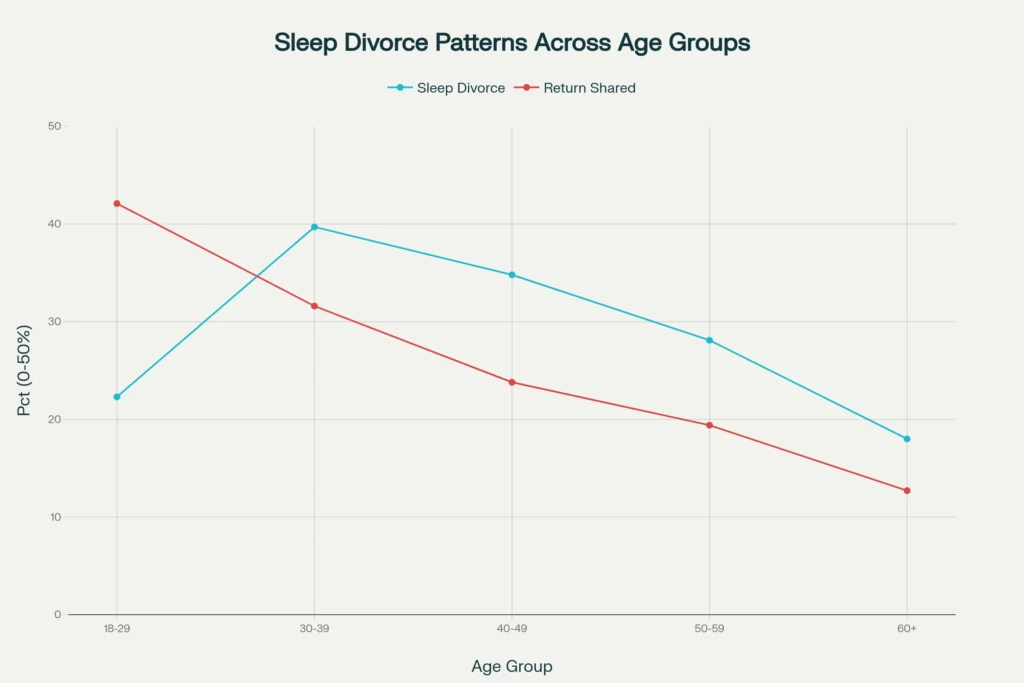Shared bed or separate? Emerging research shows the choice materially affects both sleep and relationship dynamics. Large studies across thousands of couples clarify when a “sleep divorce” helps—and when it harms intimacy.
The Sleep Divorce Revolution: Scale and Scope
One-third of American adults now sleep separately from their partners at least occasionally, with 31% reporting some form of sleep separation. Arrangements span from separate beds in the same room (13% of couples) to separate bedrooms (23%), reflecting a shift toward customising sleep for health and relationship quality.

The Paradox: Sleep Quality vs Relationship Quality
What’s best for sleep isn’t always best for intimacy. Couples must weigh improved sleep metrics against potential connection costs.
Sleep Quality Outcomes: Objective Evidence
Separate sleeping improves hard sleep metrics:
- Sleep quality scores: 7.8 vs 6.2 (co-sleeping)
- Sleep duration: 460 vs 423 minutes (+37 minutes/night)
- Sleep efficiency: 89.2% vs 82.4%
- Awakenings/night: 2.3 vs 4.8
Gains of this size are clinically meaningful for daytime functioning, mood, and physical health.
Relationship Quality Outcomes: The Intimacy Cost
Co-sleepers score higher on connection metrics:
- Relationship satisfaction: 7.8 vs 6.9 (separate)
- Sexual frequency: 8.4 vs 6.2 times/month
- Intimacy scores: 8.1 vs 7.2
- Partner acceptance: 8.2 vs 6.8
Note: Co-sleepers report more weekly conflicts (2.1 vs 1.4), likely reflecting sleep loss effects on emotion regulation.

The Subjective Sleep Paradox
Despite worse objective sleep, co-sleepers report higher subjective sleep satisfaction (7.1 vs 6.4), showing proximity can feel restorative even when sleep is lighter or more fragmented.
The Science of Shared Sleep
REM Sleep Enhancement
Co-sleeping increases REM by ~10% (22.1% vs 20.1% of total sleep), with less fragmentation and longer continuous REM—key for emotion regulation and memory. The effect is strongest in people with lower external social support.
Sleep Synchronisation
Couples align sleep stages for ~78.6% of the night, synchronising minute-to-minute and across ±5-minute intervals. Greater synchrony tracks with deeper relationship satisfaction, suggesting bio-behavioural coupling.
The Movement/Arousal Trade-off
Co-sleeping raises limb movements by ~51% and arousals by ~43%. Many couples still rate sleep as acceptable when the relationship feels secure.
When Sleep Divorce Helps
Medical Sleep Disorders
Sleep apnoea (CPAP) scenarios benefit most: separate sleeping can add 60+ minutes/night for the non-CPAP partner. Movement disorders (e.g., restless legs) can cause 2–3× more partner awakenings, often justifying separation.
Chronotype Mismatches
Morning–evening mismatches cost both partners: forced alignment reduces sleep quality by ~15–20%. Shift workers: ~68% say separate sleeping is essential for both sleep and harmony.
Snoring and Sleep-Disordered Breathing
Snoring drives 68.4% of sleep divorces. Severe cases can trigger 3–7 partner awakenings/hour. Women report greater relationship distress from partner snoring and are ~2.3× more likely to initiate separation.
Temperature and Environment
34.6% of couples cite temperature differences. Optimal comfort can vary by ≈4–5 °C between partners. Light, noise, and mattress firmness create irreconcilable issues for ~15–20%, making separation the practical solution.
When Sleep Divorce Backfires
Attachment Style Vulnerabilities
Anxiously attached partners fare worst with separation: most still prefer co-sleeping, and separation typically reduces relationship satisfaction. Securely attached partners adapt with minimal satisfaction change.

Gender Differences
Women report larger drops in relationship and sexual satisfaction with long-term separation and a stronger desire to return to co-sleeping.
Duration Effects
Long-term separation (≥2 years) correlates with lower satisfaction and ~31% lower sexual frequency; only ~18% return to co-sleeping. Temporary separation (<6 months) shows minimal relationship impact and high return rates.
The Age Factor
Peak Sleep Divorce Years
Ages 30–39 peak at ~39.7%. Younger couples separate less but return to co-sleeping more. Older couples separate less, often due to tradition and lower sensitivity to sleep disruption.
Return-to-Co-sleeping Patterns
Return likelihood declines with age, indicating younger couples treat separation as temporary problem-solving; older couples tend to adopt it as a stable arrangement.
Solutions and Interventions

Highest-Impact Interventions
- CPAP for apnoea: +3.9 sleep-quality points; partners gain 65+ minutes/night; relationship preservation 9.2/10.
- Separate beds, same room: +2.4 points; preservation 8.7/10; ~67% stick with it.
- Bedroom optimisation (light, sound, temperature, bedding): +2.6 points; ~78% adoption; cost-effectiveness 8.3/10.
Most Accessible Solutions
- Sleep hygiene education: ~84% adoption; cost-effectiveness 9.2/10; relationship preservation 8.1/10.
- Couples sleep therapy: preservation 8.9/10; adoption ~31.7%; lower cost-effectiveness due to fees.
Clinical Guidelines
Strong Candidates
- Medical: apnoea with CPAP issues, severe movement disorders, seizure-related sleep disturbance, chronic insomnia disrupting partner.
- Lifestyle: rotating shift work, large chronotype gaps (>3 hours), treatment-resistant snoring, irreconcilable environment needs.
Poor Candidates
- Attachment vulnerability: anxious attachment, recent betrayal/trauma, active depression/anxiety, strong cultural/religious objections.
- Early relationships: under 2 years, not cohabiting full-time, unresolved intimacy/sexual issues, weak communication skills.
Recommended Trial Approach
Phase 1 (2–4 weeks): temporary separation; track sleep, satisfaction, intimacy, mood/stress.
Phase 2: alternate nights together/apart; identify triggers; test modified co-sleeping; find the sweet spot.
Phase 3 (after 3–6 months): decide long-term plan; schedule periodic reviews; stay flexible; involve professionals if stuck.
Future Considerations: Tech & Innovation
Sleep Technology
Dual-zone smart mattresses can resolve temperature conflicts (common in ~35% of couples). Advanced trackers can align schedules to cycles; noise-control solutions target snoring-related disturbances.
Relationship Tech
Couples sleep apps combine two-person sleep and relationship check-ins; virtual intimacy tools help maintain closeness during temporary separation.
Conclusion: The Nuanced Truth
Sleep divorce is context-dependent. It helps when medical/lifestyle drivers disrupt sleep and couples remain intentionally connected. It harms when attachment insecurity, indefinite separation, and avoidance of core issues erode intimacy.
Best practice for most couples: treat separation as temporary problem-solving, fix root causes where possible, maintain deliberate intimacy, and reassess regularly.
For clinicians: use an individualised assessment that integrates sleep medicine, relationship dynamics, and psychology—no one-size-fits-all rule.
For couples: prioritise both sleep and the relationship. With a structured trial, targeted fixes, and ongoing check-ins, you can have great sleep and a great relationship—without defaulting to permanent separation.



